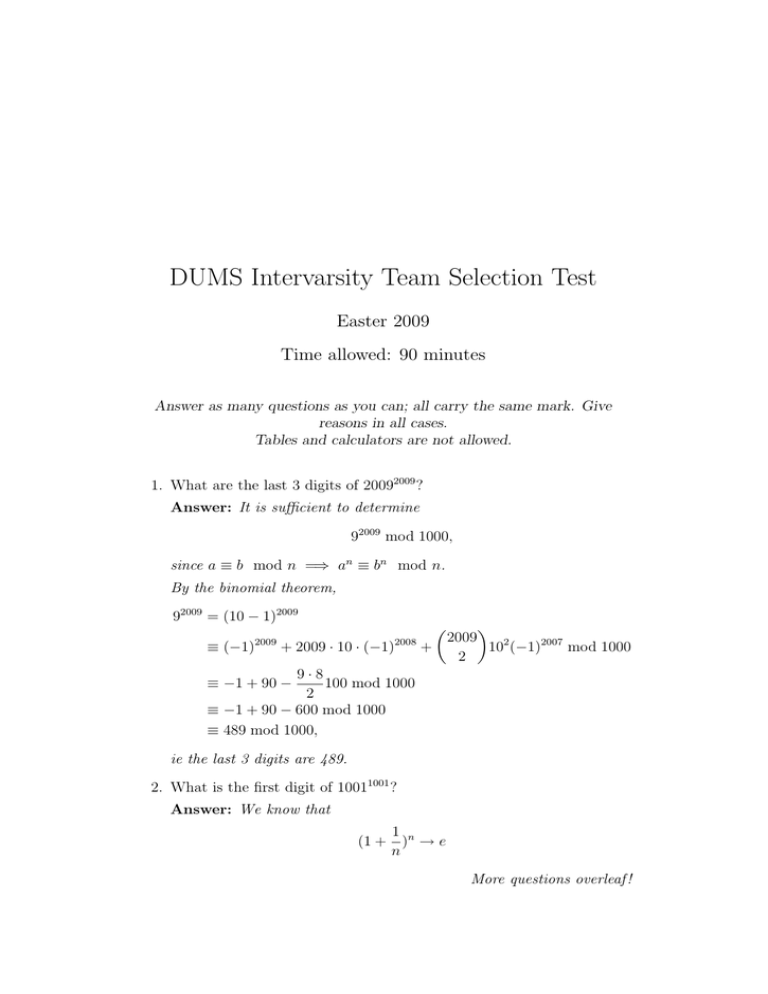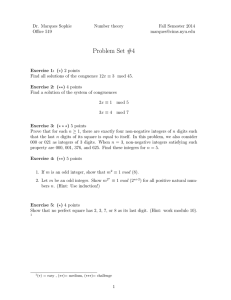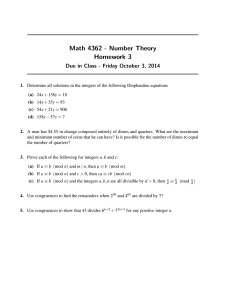DUMS Intervarsity Team Selection Test Easter 2009 Time allowed: 90 minutes
advertisement

DUMS Intervarsity Team Selection Test
Easter 2009
Time allowed: 90 minutes
Answer as many questions as you can; all carry the same mark. Give
reasons in all cases.
Tables and calculators are not allowed.
1. What are the last 3 digits of 20092009 ?
Answer: It is sufficient to determine
92009 mod 1000,
since a ≡ b mod n =⇒ an ≡ bn mod n.
By the binomial theorem,
92009 = (10 − 1)2009
2009
≡ (−1)
2008
+ 2009 · 10 · (−1)
2009
+
102 (−1)2007 mod 1000
2
9·8
100 mod 1000
2
≡ −1 + 90 − 600 mod 1000
≡ 489 mod 1000,
≡ −1 + 90 −
ie the last 3 digits are 489.
2. What is the first digit of 10011001 ?
Answer: We know that
(1 +
1 n
) →e
n
More questions overleaf !
as n → ∞.
1
The first digit of 10011001 is the same as the first digit of (1 + 1000
)1001 .
But
1 1000
)
≈ e = 2.6 . . . .
1000
The additional factor (1 + 1/1000) will not affect the first digit. Thus
the first digit is 2.
(1 +
[And the first 2 digits are 26.
If asked to justify the argument above we would go back to the proof
that (1 + 1/n)n → e, by taking logarithms, with
log(1 + 1/n) = 1/n − 1/2n2 + 1/3n3 − · · · ,
so that
log(1 + 1/n)n = 1 + O(1/n).
It would be a straightforward matter to verify that the error involved in
omitting the terms after the first is not sufficient to alter the first, or
even the first 2, digits.]
3. Show that, in any collection of 52 distinct positive integers, there are
two distinct numbers whose sum or difference is divisible by 100.
Answer: If 0 and/or 50 are among the 52 integers, ignore them. Let
the remaining integers be x1 , . . . , x50 . Consider the 101 integers
{50, ±x1 , . . . , ±x50 }.
There are 100 residue-classes mod 100. Hence (by the pigeon-hole principle) two of these must lie in the same residue-class, ie
xi ≡ xj mod 100 or xi ≡ −xj
mod 100.
In the first case xi − xj is divisible by 100; in the seond case xi + xj is
divisible by 100.
4. Six positive integers are written on the faces of a cube. At each vertex,
the numbers on the 3 adjacent faces are multiplied. The sum of these
8 products is 105. What is the sum of the 6 numbers on the faces?
Answer: Choose two opposite faces. Let the numbers on these be a, b.
Let the numbers on the remaining 4 faces (going round the cube) be
cdef . Then the sum of the products involving the first face is
a(cd + de + ef + f c) = a(c + e)(d + f ).
2
Similarly, the sum of the products involving the second face is
b(cd + de + ef + f c) = a(c + e)(d + f ).
Hence the sum of all the products is
(a + b)(c + e)(d + f ).
But
105 = 3 · 5 · 7.
Hence
a + b, c + e, d + f = 3, 5, 7
in some order. We conclude that
a + b + c + d + e + f = 3 + 5 + 7 = 15.
5. Find all integer solutions of
8xy + 5x + 3y = 0.
Answer: [There are various approaches to this very simple problem.]
Multiplying the equation by 8,
64xy + 40x + 24y = 0,
ie
(8x + 3)(8y + 5) = 15.
Thus
(8x+3, 8y+5) = (1, 15), (−1, −15), (15, 1), (−15, −1), (3, 5), (−3, −5), (5, 3), (−5, −3).
Each of these determines x, y. The only cases giving integer values to
x, y are
(8x + 3, 8y + 5) = (3, 5) =⇒ (x, y) = (0, 0)
(8x + 3, 8y + 5) = (−5, −3) =⇒ (x, y) = (−1, −1).
3
6. Suppose Ireland and Wales are equally strong at rugby. Which is more
likely, that Ireland wins 3 games out of 4, or that Wales wins 5 games
out of 8? (Ignore the possibility of draws.)
Answer: The probability of Ireland winning 3 games out of 4 is
4 1 4 1
( ) = .
3 2
4
The probability of Wales winning 5 games out of 8 is
7
8 1 8
( ) = .
32
5 2
Thus it is more likely that Ireland wins 3 games out of 4.
7. Given a point P and a circle Γ, suppose a line l through P cuts Γ in
X, Y . Show that P X.P Y is independent of l.
Answer: Suppose P XY, P X 0 Y 0 are two such lines. Consider the triangles P XY 0 , P Y X 0 .
Recall that the angle AXB subtended by a chord AB in a circle is
constant. Hence the angles ∠P XY 0 = ∠X 0 XY and ∠P Y X 0 = ∠Y 0 Y X
are equal.
The two triangles also have the angle ∠XP X 0 in common. Hence the
two triangles have the same angles, and so are similar.
It follows that
PX
PY
=
0
PY
P X0
ie
P X · P X 0 = P Y · P Y 0.
8. Suppose p(x) is a polynomial with integer coefficients such that
p(0) = p(1) = 2009.
Show that p(x) has no integer zeros.
Answer: Consider the polynomial
f (x) = p(x) − 2009.
4
We have
f (0) = f (1) = 0.
Hence
f (x) = x(x − 1)q(x)
for some polynomial q(x), ie
p(x) = x(x − 1)q(x) + 2009.
If
p(n) = 0
then
n(n − 1) | 2009.
But
2009 = 7 · 287.
Thus
n ∈ {±1, ±7, ±287, ±2009}.
But in none of these cases does (n − 1) | 2009.
9. Suppose the sequence xn satisfies
lim (xn+1 − xn ) = 0.
n→∞
Show that
xn
= 0.
n→∞ n
lim
Answer: Given > 0 we can find N such that
|xn+1 − xn | < /2 if n ≥ N.
If x ≥ N then
xn = (xn − xn−1 ) + (xn−1 − xn−2 ) + · · · + (xN +1 − xN ) + xN .
Hence
|xn | ≤ |xn − xn−1 | + |xn−1 − xn−2 | + · · · + |xN +1 − xN | + |xN |
≤ (n − N )/2 + |xN |
Thus
|an /n| ≤ /2 + |xN /n|.
5
Now choose M such that
|xN /n| < /2
if n ≥ M . Then
|xn /n| < if n ≥ max(M, N ).
Hence
xn /n → 0.
10. Does there exist a differentiable function f : R → R, not identically
zero, such that
f 0 (x) = f (x + 1)
for all x?
Answer: Let us try
f (x) = ecx .
This will satisfy the given equation if
cecx = ec(x+1) = ec ecx ,
ie if
c = ec .
Now it is easy to see that c 6= ec for any real number c; for if c < 0
then ec > 0, while if c > 0 then ec > c.
However, we may be able to find a complex number c such that
ec = c;
and then
f (x) = <(ecx ) = cos(cx)
will satisfy the given relation.
Thus there is a solution provided the function
f (z) = ez − z
has a zero.
6








